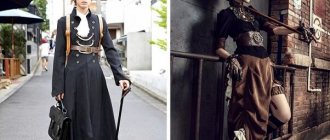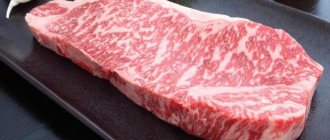Western influence
Considering the essence of Japanese subcultures, it is worth noting the significant influence of the West on them. The roots of all the phenomena and trends that you can find in this Asian country actually come from Western society.
It is interesting that initially the inhabitants of Japan had an extremely negative attitude towards Europeans. For example, the Portuguese, who landed on the shores of this country in 1543, almost immediately received the nickname “southern barbarians.” For a long time, the appearance and clothing of Europeans was perceived by the Japanese as lacking elementary beauty and was ridiculed in every possible way. And when Tokugawa came to power, most Europeans were simply expelled from the country.
2.2. Manga
Along with anime, after the collapse of the Soviet Union, manga began to penetrate into Russia. Initially, manga was perceived by society as a comic book, and reading it was considered only a child's hobby, but over time, the opinion changed. Children, youth, and adults found interest in it. Such a wide reach of readers was possible due to the huge number of different genres: from simple comedies to blood-chilling mystical stories and intricate detective stories.
There is a widespread belief among fans that this genre is an order of magnitude higher, more thoughtful and better drawn than other comics. It’s not for nothing that some manga have been written for years or decades, for example the manga “Oda Sensei”, the first issue of which was in 1996 and is still being published.
In Russia, the most famous works are considered to be “Naruto” and “Bleach”, which have found fans in different parts of the country.
In Russia, interest in manga has reached such a level that special companies are appearing that buy the right to translate into Russian, these are Comics Factory, Comix-ART, Palma Press and Sakura Press. They are not limited to translations and also publish works by Russian artists. In support of beginning mangaka, since 2009, the IZM publishing house has been publishing the RuManga magazine, and in 2011, Comics Factory presented a collection of short comics, Almanac of Russian Manga[18].
Second wave of Westernization
A new wave of influence of European society on the Japanese has been observed since the late 19th – early 20th centuries, when the Meiji Restoration took place in the country. Now European clothing was increasingly replacing Japanese clothing. Looking Western was already considered fashionable and prestigious.
In the 1920s, young women began to appear who listened to jazz and ignored traditional rules of conduct for Japanese women. After defeat in World War II, Americans settled an entire area of Tokyo called Hirojuku. Japanese youth increasingly began to visit there to become familiar with Western culture. In the 1950s, Hirojuku began to be considered a symbol of Western culture, and it is from here that some Japanese subcultures have their origins.
Already at that time, young Japanese women were addicted to solariums to acquire dark skin, and guys wanted to be like hip-hop artists from the United States. To look like foreigners, many begin to lighten their hair.
The traditional family model no longer works
The steady increase in Japan's single population indicates that the family model that developed in the country after the Second World War during the period of the economic miracle and was based on a clear division of labor into male and female is no longer effective. There is a growing gap between those who are able to start a family according to this model, and those who remain alone forever.
During the period of economic growth (1955-1972), it was not very difficult for young men to find stable work in an enterprise with good and constantly increasing salaries, so almost all of them had the opportunity to create a traditional family. However, after the 1973 oil crisis, wages for young workers virtually stopped growing, and women contemplating marriage decided to wait until their potential husbands earned enough money. Thus began the trend of late marriages. Late marriages became possible largely thanks to parents who managed to save enough money to allow adult children to live with them under the same roof. This is where the phenomenon of “lone parasites” arises. At the same time, married women started working part-time and thus, even despite their husband’s salary stopping growing, they could afford a comfortable existence. That is, the current situation motivated married women to go to work. So the foundations of a traditional family, where the husband works for the general well-being and the wife takes care of the house, although they were not broken, have already shown the first cracks.
However, since the second half of the 90s, especially after the Asian financial crisis of 1997, the number of “free plowmen” among young people, constantly moving from one low-paid job to another, has sharply increased. The economy was undergoing a period of restructuring and many young people were finding it difficult to obtain regular employment. In addition, at that time, permanent work, as a rule, meant lifelong employment, so the difference in the position of permanent workers and temporary workers became more and more noticeable. And while a permanent worker could afford to support a traditional family, this prospect became increasingly distant from a temporary worker. The result of this was the decline in the number of Japanese people getting married, which we have already discussed, and the decline in the birth rate.
Denial of traditions
According to researchers, many subcultures in Japan are based on the denial of ancient traditions that have determined the mentality of the inhabitants of this country for centuries. Public expression of one's feelings and excessive emotionality have always been considered unacceptable.
Some trends, of course, have continued. For example, the Japanese even today place work for the benefit of the team higher than their own ambitions and desire to move up the career ladder. These traditions can be traced in modern etiquette.
At the same time, a departure from established rules can be traced in the Japanese subculture among girls. Now the idea of Japanese women is completely opposite to what existed a couple of decades ago.
Japanese girls
It is girls who often become the main representatives of the Japanese subculture. If previously Japanese women were expected to be silent, meek and obedient, then they began to dress flashily and provocatively, emphasizing their sexuality. Moreover, they behaved deliberately cheekily.
Over time, the idea spread in Japanese society that a representative of the fairer sex has every moral right to dress as she pleases in order to demonstrate to everyone around her, without exception, her internal conformity with her clothing style.
Protest against traditional ways of life is extremely popular among modern youth; it can clearly be seen in some types of Japanese subculture. For example, on Japanese television it is still prohibited to talk about the life of sexual minorities, and when in 2006, for the first time in the history of local television, a documentary film about lesbians and gays was shown, for the vast majority of residents it became a truly revolutionary event. At the same time, musicians of fashionable Japanese groups wear stylized women's clothing and act out love relationships between men during their performances only in order to demonstrate their aesthetic ideals, shock and attract new fans.
The denial of traditional ideals often reaches the point of absurdity. For example, on the streets of Harajuku, which still remains one of the most fashionable, you can meet men in skirts who are not representatives of sexual minorities, and wear women's clothing to demonstrate their protest against society.
Hickey in Russian
Flickr/L'hò»>
In Russia, too, there are people who have not left their homes for years. Today on VKontakte there are dozens of communities dedicated to hikikomori. As a rule, entries in these social groups are devoted to Japanese popular culture and a little of the reasoning of the radical homebodies themselves. The most popular community has up to 400,000 subscribers.
One of the representatives of the popular Japanese movement in Russia, who has not left his home since the end of 2012, agreed to tell Life #Home his story on condition of anonymity:
“I live in a small southern city. In an apartment building on the outskirts. We have a three-room apartment. After my grandmother died 11 years ago, I moved from a 12-meter nursery to a 20-meter grandma's bedroom. Mom and stepfather live in the living room. Thanks to the balcony, I hardly notice the change of day: it is glazed and covered with film (our sun is too bright). Our house is on a hill, sometimes at night I open one of the balcony windows and look at the sleeping city at my feet.
I had never heard anything about hikikomori and did not consider myself one of them. The catalyst for the last “sorry” was the betrayal of my then-beloved girlfriend. I found her in the kitchen with my stepfather. Moreover, she did for him what I never got to do even on my birthday. I don’t remember what I shouted then, but it was definitely something offensive.
That day in the morning I took out the trash, and that was the last time I went outside - December 29, 2012.
I organized the space in my room according to the principle of a spiral of needs. Where in the very center there is a table with a computer, and less important objects and things like trash cans, a chest of drawers with underwear, an air mattress, etc. diverge clockwise from it. Getting up from the table, I make three full circles to leave the room.
The most important thing for me was the computer. At first, my parents reacted quite violently to my new way of life. But over time, my mother came to terms with it and even began to help me. For example, on Sundays she prepares food for me for the whole week, puts it in containers and takes it to the refrigerator on my balcony. Once a month she helps me with cleaning and disinfection. Lately, bedbugs have been haunting me, and no poison will stop them. I can’t use strong chemicals, because then I’ll have to leave the room for several days, and that’s out of the question.”
Victorian style
"Lolita" is a Japanese subculture that is based on wearing costumes from the Rococo era and the times of Queen Victoria of England. Gothic fashion has been gaining popularity lately. Today it is one of the most popular subcultures in Japan. Fashion, which you need to conform to in order to be considered one of them, is liked by many.
The classic “Lolita” costume, which today can be found on the streets of Tokyo and other major Japanese cities, consists of a knee-length dress or skirt, blouse, headdress, high heels (or boots with an impressive platform).
This style emerged in the late 1970s, when several major labels began selling such clothing. In the 1990s, the popularity of this subculture in Japan (photos of which you will find in this article) was added by the gothic rock band Malice Mizer.
It is interesting that the name Lolita in the name of the subculture itself is not directly related to the novel of the same name by Nobel laureate Vladimir Nabokov. The representatives of this movement received this name due to their costumes and style, which is reminiscent of dresses for children. At the same time, no emphasis is placed on their lifestyle and sexual preferences.
Life in 2D style
Since we started with the drawing culture, let's see where it led. In Japan, the term "otaku" is used to describe people who are passionate about something. Outside the Land of the Rising Sun - including in Russia - this is what anime and manga fans call themselves and each other. But at home, the meaning of the word is much broader, and it is used less readily due to its derogatory connotation. In Japan, fans of cartoon culture are often called “Akihabarakei”, after the local mecca of otaku - the Akihabara quarter of Tokyo's Chiyoda district, where such characters like to gather. Central to otaku culture is the concept of “moe” - essentially the fetishization of fictional characters with all that it implies. Otaku likes to dress up in costumes of their favorite heroes (they call this transformation “cosplay”), buy posters, figurines, life-sized pillows and other paraphernalia depicting the object of their adoration. Given a choice, they would choose to live in a 2D cartoon world. If this type of otaku is bright, sociable guys who love to show off in front of a shocked public, then other extremely enthusiastic individuals have chosen the polar opposite path. It’s difficult to call them a subculture, but they, like no other, demonstrate all the ins and outs of the social contradictions of modern Japan. We are talking about “hikikomori”, or simply “hikki”. This is the name given to young people (students or men during a midlife crisis) who could not withstand the pressure of society and voluntarily abandoned any contact with the outside world. They usually do not have a job, lock themselves in a room and live dependent on relatives, spending their days watching TV, reading manga or playing computer games. Such urban hermitage can last for years, sometimes decades. According to the Japanese Ministry of Health, Labor and Welfare, more than half a million young people aged 15 to 39 have not left their homes for more than 6 months, and this alarming statistic continues to grow. Yes, not every hikki is an otaku and not every otaku is a hikki, but what they have in common is that both of them escape from a frightening reality into fantasy worlds.
Types of "Lolita"
Now on the streets of this Asian country you can find several types of “Lolita”. Classic is the most mature example; in clothing it is focused on the Baroque style. It is most often seen as a mature and sophisticated style due to the use of intricate patterns and muted colored fabrics. The makeup of such girls is rarely flashy; the emphasis is on a natural look.
Initially, “Gothic Lolita” became extremely popular. It arose as a social protest against careless and overly bright gyaru, which will be discussed in more detail later. This type is characterized by dark clothing and makeup. Black eyeliner around the eyes and bright red lipstick are the main elements. As a rule, clothes are black. In extreme cases, white, dark red or purple. Jewelry typical of European Goths is popular. Gothic style wallets and bags with images of bats, coffins and crosses are also common.
"Sweet Lolita" originated from Victorian England and the Rococo era. Everything here is focused on the childish aspect of the character. The costume is based on clothes of cheerful bright colors, which are also called “candy colors”. Cosmetics enhance the natural look to preserve a child's face. For such a “Lolita,” the emphasis on infantility is important. The indispensable attributes of a costume are lace, an umbrella, bows, and ribbons. You can often see references to Alice from Wonderland, classic fairy tales, sweets and fruits.
"Punk Lolita" combines elegance with punk aggression. A popular suit consists of a skirt and a T-shirt (or blouse). The feet most often wear shoes or boots with double soles.
What does it mean to be a Japanese teenager?
April 24, 2021
Daniil Palash, an eighth grade student at the Novinskaya school, knows the answer to this question. In January-February this year, he took part in the competition “What does it mean to be a Japanese teenager? Diary of a Researcher,” which was announced by the interregional charitable public foundation for promoting the development of international educational programs “Interculture” (AFS Russia) together with the Japanese Embassy in Russia.
Moreover, among the 11 winners (250 works were sent to the competition), he was invited to spend spring break in Moscow. The finalists came from different parts of the country: Yekaterinburg, Vladivostok, Cheboksary, Krasnodar Territory, Yaroslavl, Rostov, Moscow and Nizhny Novgorod regions.
– Was it an unusual vacation, a vacation-gift? – I ask Daniel. – Of course, everywhere we’ve been! We got acquainted with the sights of the capital, walked around Moscow, and talked. In the cultural center of the Likhachev plant (ZIL), in the scientific laboratory of biology of the Polytechnic Museum, we had the most interesting classes. At the Japanese Culture Department of the Japan Foundation, we studied the art of calligraphy. First time I saw rice paper. We visited the exhibition “Beauty in Japanese”, the Russian representative office of Japanese Airlines and Sumitomo Mitsui Rus Bank, located in the international business center. From the windows of one of the skyscrapers we admired the panorama of the capital. The excursion around the territory of the Moscow Kremlin was memorable and I was amazed by the Garage Museum of Contemporary Art. A visit to the Botanical Garden of Moscow State University will forever remain in my memory. M.V. Lomonosov "Apothecary Garden", the oldest in Russia, founded by Peter I in 1706. We learned a lot of interesting things about waste recycling during a master class at the Resource Saving Center. And on March 29 at the Japanese Embassy
– What was this competition like? Why were Russian schoolchildren asked to try to feel like Japanese teenagers? What kind of researcher's diary is this? – By agreement of the Ministers of Culture of Russia and Japan, Vladimir Medinsky and Hirokazu Matsuno, 2021 has been declared the cross year of Russia and Japan. My mother was the first to know about this unusual competition and got me interested in the idea of participating in it. Having studied the characteristics, traditions and rules of behavior of a Japanese teenager at home, at school, his daily routine, diet and food culture, lifestyle, I learned a lot of interesting things. From the five sections of the proposed list, I chose several points and tried to follow them continuously for two weeks. As required by the terms of the competition, I kept daily entries in the researcher’s diary. I summed up the results at the end of each week, noting how much I managed to follow the rules, and if it didn’t work out, I explained why. I tried to talk about changes in myself and about the attitude of family members, friends, and classmates to my research. Having completed the work, I answered the final questions, and together with my mother, I created and posted on the Internet a reporting video about my research.
– Daniil, what rules of a Japanese teenager did you decide to follow? – For example, at home I had to learn how to always keep my wardrobe in order. I had to sort out all my clothes and put aside what I hadn't worn for a long time. Distribute the rest by type of clothing, clean (hem), and carefully fold in the closet. Remove unnecessary items from your desk, neatly arrange books, organize your workspace, and constantly maintain order everywhere. Drink green tea without sugar and eat with chopsticks. At school, do not use gadgets in class, do not be late for classes, and in your free time communicate with classmates in person, and not on social networks. In addition, try to maintain a positive attitude in any situation and smile.
– How did your classmates and friends react to your participation in the competition? It’s clear that you were carried away by your mother, but by your father and younger brother?.. – In general, everyone supported me. Our family members “plunged” into the project with me. Mom helped me print out various versions of the Japanese game Sudoku (a puzzle with numbers), and during the break I had no time for the phone or the Internet; my classmates and I organized competitions in solving Rubik’s cubes, solved Sudoku and Japanese crosswords. Everyone in our family is interested in chess, my dad even collects them, so we started studying Go with him. This is a logic board game, translated from Japanese as “hand talk” or “hand talk.” It's very similar to chess, and it captivated us. My younger brother and I practiced origami and learned how to make cranes. Of course, we learned about a Japanese girl from Hiroshima, Sadako Sasaki, who made cranes in the hope of a miracle. Summing up the results of the second week of competition tasks, Daniil will write: “Dad was happy to see my desire to lead a healthy lifestyle and follow a daily routine; my mother praised me for my neatness, organization and active acquisition of new knowledge.”
– How did you feel following the rules of a Japanese teenager? Was it difficult? What did this competition change in you? – I definitely cannot answer the question of whether it is difficult to be a Japanese teenager, but there is no doubt that the competition aroused interest in Japan, enriched me spiritually, broadened my horizons and gave me a lot of positive emotions and vivid impressions. We are different, but we have something in common. I can say that I discovered another culture, and this helps me study the culture of my country. As one of the sensei (personal teacher, master in a certain field) said, “it’s worth trying to start studying the Japanese language, if only in order to understand the true strength and power of the Russian language.” I love my small homeland very much and am proud of the people who glorified it. Participation in the project expanded the boundaries of my world. For the opportunity to participate in it and for the support, I am grateful to the school’s teachers and, of course, to our director Irina Gennadievna Sataeva.
– Please tell me, could any schoolchild take part in this unusual competition, or were there any restrictions? – Absolutely anyone who is interested in discovering the world.
– Did you manage to do it? - I think yes.
Author: SHUBAEVA Elena
leave a comment
Your comment has been added.
"I can't live without men"
This advertising slogan for European jeans from the 1970s has become a motto for young girls who consider themselves part of the Japanese gyaru subculture. Its name comes from the English distortion of the word girl, which translates as “girl”.
Modern representatives of this movement have earned the epithets “degenerate schoolgirls” and “making parents cry.” They are assessed this way because of their desire to break traditional taboos for this country, for their excessive passion for Western values.
Classic gyaru are distinguished by their openly frivolous behavior, passion for fashionable and bright clothes, positive thinking in any situation, and their own ideas about the ideals of beauty. It is noteworthy that men can also belong to this Japanese subculture (photos of which you can see in this article). In this case they are called gyaruo. When they appeared, they quickly became one of the key elements of street fashion.
Japanese youth subcultures
Japanese youth subcultures are a number of subcultures among Japanese youth, distinguished by their own philosophy, clothing style and musical preferences. Inextricably linked with street fashion , the term "Japanese street fashion" is also often associated with subcultures, sometimes these terms replace each other. Most subcultures appeared as a protest against traditional Japanese ideals of beauty and social norms.
Japan's first youth subcultures emerged from young people experimenting on the streets of Tokyo. Initially, this phenomenon was simply called street fashion (ストリートファッション | sutori:to fassen).
With the emergence of increasingly disparate and dissimilar directions, a term with a broader meaning was needed. Such a concept, designed to cover all fashion trends in clothing, was the term “Japanese street fashion,” which refers to the appearance of fashionable Japanese youth on the streets of Harajuku and Shibuya. Outside of Japan, the term "Japanese street fashion" is usually used to refer to Harajuku fashion, while within Japan it refers to all youth fashion trends and, more broadly, to all youth subcultures. Sometimes it even becomes synonymous with all Japanese subcultures in general. Modern youth subcultures
The center of Japanese youth subcultures is the Harajuku quarter in the Shibuya area, where the “Lolita” style and the mixed “fruits” style appeared. Shibuya is also the birthplace of gyaru, and the Akihabara quarter in the Chiyoda district is a mecca for fans of Japanese animation (anime) and comics (manga). At the moment, there are several main areas of typically Japanese subcultures.
Lolita Fashion "Lolita" (Japanese: ロリータ・ファッション Rori:ta fassen?) is a subculture based on the style of the Victorian era, as well as on the costumes of the Rococo era and partly on elements of Gothic fashion. “Lolita” is one of the most popular subcultures in Japan, leaving its mark in fashion, music and fine arts. A Lolita costume usually consists of a knee-length skirt or dress, a headdress, a blouse and high heels (or platform boots).
Lolita store in Harajuku Prototypes of future Lolita fashion can already be seen in the fashion of the Rococo era, for example, in the fashion of Europe at that time. Combining Victorian and Rococo elements, Lolita also borrowed from Western traditions and elements of Japanese street fashion itself. Despite the fact that Lolita fashion imitates typical European images, it has become a purely Japanese fashion and cultural trend. The ancestor of the style was the “Gothic Lolita” subculture. A more common name in Romaji is Gothic & Lolita. Journalist Suzuki Mariko, who researched the issue, said that the term came about because of the "gothic" elements in their clothing. She also said that when she met girls “dressed like dolls” in Harajuku in May 1998, she learned that they called the style “Gothic & Lolita.” Terms such as gosu-rori, goth and rori, gothic Lolita, gothic and Lolita, “gothic Lolita” fashion and “gothic Lolita” style can also be used equally. The name of the most popular magazine dedicated to the “Lolita” subculture is “Gothic & Lolita” Bible" - also refers to the name of the progenitor subculture of this trend. Therefore, all related styles are often mistakenly called Gothic & Lolita. In addition to the Gothic, the “Lolita” direction includes “sweet” (infantility, bright, “candy” colors), classic (the most detailed imitation of Baroque and Rococo styles), punk, guro (victim style: fake blood, bandages, etc. are used as props . p.) and other sub-styles.
Gyaru (Japanese ギャル?) - Japanese transcription of gal from the distorted English girl (English Girl). The term can mean both the Japanese subculture popular among girls, which peaked in the 1990s, and the way of life itself. The name comes from a 1970s advertising slogan for the GALS jeans brand - "I can't live without men", which became the motto of young girls. Today's gyaru, like their varieties kogyaru and ganguro, have earned the nicknames "oya o nakaseru" (making parents cry) and "daraku jokusei" (degenerate schoolgirls) for breaking traditional Japanese taboos and indulging in Western values. The motto of the kogyaru is Biba jibun! (“Long live I!”). They are distinguished by their frivolous behavior, positive thinking, love of bright fashionable clothes, and special ideas about the ideals of beauty. Men, the so-called “gyaruo,” can also belong to the gyaru subculture. Since their inception, gyaru have become one of the most important elements of Japanese street fashion. The rise in popularity of gyaru in the 1970s was associated with the appearance of the first gyaru magazine, Popteen, which became a cult favorite among Japanese women of that time and taught them how to be sexy. Subsequently, many different gyaru publications appeared, such as “Street Jam” and “Happie”, with most of their creators coming from the porn industry. In the 1980s, many gyaru joined the ranks of the so-called “Yankiis”. These were the Kogyaru who were expelled from schools for refusing to wear traditional school uniforms in an effort to demonstrate their independence to adults. The Gyaru visited the Shibuya area, where fashion magazine photographers could always find them. In the mid-1990s, kogyaru culture became famous throughout Japan due to media coverage of the practice of enjo-kosai (paid dates), which effectively allowed journalists to make the word gyaru synonymous with prostitution. The 1997 documentary Baunsu KO gaurusu, directed by Masato Harada, depicts kogyara and gyaru as young girls who turn to prostitution for fashion and expensive accessories. The Kogyaru also have a special slang, Kogyarudo (コギャル語), an essential element of their culture. For example, they call their boyfriends ikemen (Japanese: イケ面 “cool dude”?), which is cho: kawaii (超かわいい - “very cute”). The kogyaru herself (gyaru-yatte, "his gyaru") buys gyaru-fuku (gyaru clothes) from a gyaru-kei seppu (gyaru store), if, of course, she can find something that is not "really super sickening" (超マジで むかつく, chō: maji de mukatsuku)[12]. Gyaru often use foreign words, Latin abbreviations of Japanese phrases, or simply foreign endings without regard to Japanese syntax. For example, the suffix “-ingu” (from the English -ing) can be added to words, for example, getting (Japanese: ゲッティング?, “to receive”). Another feature is the use of the suffix -ra. It means "like" or "taken from" and suggests the similarity of the subject matter with the pop idol of Japanese young girls, singer Namie Amuro (from whose name the suffix was taken)
The Harajuku area is a cult place for adherents of Japanese street fashion. First of all, this area is known for the youth subculture of Harajuku Garuzu (Japanese: 原宿ガールズ?, from the English Harajuku Girls - “Harajuku girls”), with its characteristic bright costumes, abundance of accessories and “combination of incongruous” costumes can include both gothic both cyberpunk and club neon colors. Separately, we can highlight the “punk direction,” for which plaid and leather pants, the use of chains and other rock attributes are typical.
Girls in Harajuku The “Harajuku Garuzu” subculture emerged in the mid-1990s, along with the appearance on the streets of Harajuku of young people wearing costumes consisting of a huge variety of clothing items and accessories. The variety of elements in the outfits of representatives of this subculture is enormous, and the number of their possible combinations is almost limitless: on a person dressed in this way, one could see elements of European costumes mixed with Japanese ones, expensive clothes along with handicrafts or second-hand clothes. This did not go unnoticed by representatives of the fashion industry. In 1997, photographer Shoichi Aoki released the first issue of the monthly FRUITS, named after the emerging subculture, the first issue of which consisted of photographs of teenagers from the streets of Harajuku. In the same issue of the magazine, Aoki expressed his view of the movement, declaring the appearance of “fruit” to be a cultural revolution and a rebellion against stereotyped appearance. The author considered the most important property of the movement to be democracy, the opportunity for any person to join fashion, regardless of financial capabilities. Here Aoki saw a chance to confront the big brands that dictate trends in the fashion industry. The magazine immediately gained great popularity and received the status of an international publication. At the same time, the “fruits” fashion was noticed by famous Japanese designers such as Yohji Yamamoto and Mihara Yasuhiro. Thanks to them, Harajuku fashion receives even greater impetus for further development. The essence of the “fruits” ideology lies in the ability of each person to create his own ideal of modern beauty, accessible to people with any financial capabilities, and in the rejection of cliches and templates imposed from above. The main role in creating a costume is played by imagination and an almost unlimited possibility of choice. So, one day a teenager or young man can appear on the street dressed in military style - in a foreign military uniform, taking with him a gas mask as an accessory - and the next day dress up in a Pokemon costume and put on boots with very high soles. Subsequently, the fruit style was integrated into Japanese street fashion in general, glorifying Tokyo fashion. Gradually, fruit fashion became a global trend. Thanks to Aoki and several fashion brands, fashion shows and fruit festivals took place in the United States and Australia. This subculture has also penetrated into Russia. One of the representatives of Russian fruits described the development of this trend in Russia as follows[55]: Russian fruits, of course, are close to Japanese culture: anime, j-rock, j-pop and much more. It is difficult to imagine a person who belongs to fruits and does not at least feel sympathy for Japan. I came to this subculture when I became interested in anime, and I started watching anime when I became interested in Japan. Now I take Japanese language courses and listen to Japanese music. I also really like to draw, especially in the style of manga (comics) and anime. Russian fruits differ from the Japanese in some ways. For example, in Russia they can borrow some trends from gyaru, although traditionally the youth of Harajuku ignores gyaru, and some - gothic lolitas - are their staunch opponents. Fruits, along with fashion from Harajuku, have also found themselves in Japanese music, in the subgenre of visual kei - oshare kei. Initially, some oshiare groups were also called "dekora-kei" (another name for fruits) due to their demonstrative adherence to Harajuku fashion. This allowed some bands, notably An Cafe and SuG, to label their music as "Harajuku dance-rock" and popularize the fruits fashion through it.
visual kei
Visual kei fans in Harajuku Main article: Visual kei The music genre Visual kei (Japanese: ヴィジュアル系 Vijuaru kei?) arose from Japanese rock[57][58] as a result of mixing it with glam rock, metal and punk rock in 1980 -s years. "Visual kei" literally means "visual style". It is characterized by the use of makeup, complex hairstyles, colorful costumes, and its followers often resort to androgynous aesthetics. Thanks to fans, visual kei, as a subculture, was able to acquire a fashion component, while simultaneously absorbing elements of the Lolita, Fruits styles, as well as more traditional Japanese ideas about male beauty. Among visual kei fans you can also find metalheads. In the appearance of the musicians of visual kei groups, features of “Gothic Lolitas” appeared. In turn, the second wave of visual kei, with representatives such as Malice Mizer, enriched the Gothic & Lolita subculture, influencing its development and popularizing this fashion among visual kei fans with its appearance. Subsequently, “Gothic Lolita” and visual kei formed an interconnected pair of phenomena that fed each other: in magazines dedicated to “Lolitas”, articles about artists and visual kei releases became commonplace, and the most famous publication about the “Lolita” subculture, Gothic & Lolita Bible, was created under featuring Mana from Malice Mizer. The use of “Lolita” attire has become common among visual kei musicians. Typical examples include the images of the former guitarist of the band Aicle Keita, the bass guitarist of the band NoGoD, or the guitarist and vocalist of the death metal band Blood Stain Child. Many visual kei musicians have spoken about their interest in this trend in fashion.
Bosozoku
Bosozoku (Japanese: 暴走族?, lit. “aggressive racing clan”) is a semi-criminal subculture of bikers, numbering more than 42.5 thousand people in 2009. Bosozoku were so unruly and scandalous that the Japanese government eventually had to create special correctional facilities to curb them. Because of this, many teenagers ended up in juvenile detention centers and through them came even closer to the criminal world. The passion for theatrical effects, hooligan acts, and condemnation from the media and society have created a stable negative and scandalous reputation for bosozoku. All this pushed them into contact with the yakuza, right up to the transformation of bosozoku into fighters and performers of various dirty work for some mafia clans, who saw in the racers potential recruits to replenish the groups. The demonstration of mutual sympathy between part of the bosozoku and some representatives of the Japanese mafia was also beneficial to both parties. In contrast to this practice, some bosozoku went into open confrontation with the yakuza. One of the most famous fighters against the criminalization of the subculture is Makoto, who founded the Yokohama Alliance for this purpose. However, he himself was sentenced to prison for attacking one of his group members, who, as it turned out, was a drug dealer. They were originally called Kaminarizoku (雷族?, “Thunder Clans”). Popular rumor saw them as ex-kamikazes, who, due to the end of the war, did not have time to give their lives for the emperor and were seeking thrills. The modern name of the subculture appeared by chance in June 1972.
Akihabara-kei and anime culture
Girls in maid costumes at one of the Otaku maid cafes in Japan call a person who is passionate about something, but outside the country, including in Russia, this concept is usually used in relation to fans of anime and manga. In Japan, the slang term for otaku who are into anime and manga is "Akihabara-kei", which refers to young people who spend all their time in the Akihabara area and are interested in the world of anime and its elements, such as maid cafes, idols and computer games. The Akihabara area is an important center of Japanese modern culture. In the 2000s, he became strongly associated with the Japanese gaming industry and major anime and manga publishers. One of the central elements of otaku culture is the concept of moe (Japanese: 萌え?), meaning fetishization or attraction to fictional characters. Scholars of Japanese pop culture view this term in different ways. Joseph L. Dela Pena believes that the term contains pure and protective feelings towards female characters. Jason Thompson of Otaku USA magazine uses the term moe to refer to young and attractive anime characters, emphasizing the role of the beautiful woman in Japanese culture. Scot von Schilling associates moe in little girls with "longing for fatherhood" in middle-aged men. At the same time, the famous Japanese animator Hayao Miyazaki, known for his pro-feminist views, said: It’s difficult. They immediately turned into objects of fetishism. I mean, if we want to be positive and popular, we have no choice but to portray them as attractive as possible. But now there are too many people who portray [these heroines] as if they want to have [such girls] as a pet. And there are more and more such people. At the same time, more and more objects and phenomena of Japanese life are being subjected to the so-called “moefification” in Japan. For example, attractive girls and girls drawn in anime style have been used in advertising and decoration of tool boxes, road signs, garbage bags, sake, watermelons, and even Japanese airlines, which resulted in the image of Pikachu on one of the All Nippon Airways planes. Although this practice is quite common and is called "moe anthropomorphism", many Japanese consider it somewhat absurd to use moe with most such things. Another important point is the fascination with so-called idols. In this case, idols refer to popular and attractive young music artists, models and actresses. For example, men's magazine models will be called gravure idol, porn actresses - AV idol, singers and actors are usually called simply idols. Idols occupy an important place in the culture of Akihabara, for example, fans of a particular idol can purchase a special book with his photographs, a collectible CD with songs, or moe-themed porn films. There are so-called idol agencies that produce J-pop groups made up entirely of idols, such as the iconic Morning Musume. In other cases, idols who are famous in other fields may form groups or simply start a music career, such as the famous JAM Project and Aya Hirano. For all this, Akihabara has a huge entertainment network. The most famous of them are maid cafes, manga cafes, shops of various collectible and souvenir products, karaoke clubs, etc. Maid Cafe (English: Maid Cafe) is one of the main highlights of Akihabara. Their main feature is waitresses cosplaying as French maids (cosplay is one of the main elements of otaku culture, the so-called costume game. The maid uniform is one of the types of “uniform fetish” here, as well as the popular moe from anime), as well as special menus and attitude to clients. For example, waitresses, for a fee, can sing a song, play the role of a younger/older sister, or simply take a photo with a client. Such maid cafes have become so popular that some large cafes have opened their branches in countries such as China, South Korea, Taiwan, the Czech Republic, Mexico, Canada and the United States of America.
(Material taken from the free encyclopedia)
Rise in popularity
In the 1970s, their popularity was primarily due to the release of large circulations of Pop-teen magazine, which became a style icon for many Japanese women. Thanks to him, they learned to be sexy. Subsequently, many more gyaru publications appeared, and their publishers often came from the porn industry.
In the 1980s, the gyaru were joined by the so-called kogyaru, who were expelled from schools for refusing to wear traditional uniforms. They did this out of a desire to appear mature and demonstrate their independence to others.
In the 1990s, many foreign journalists began to talk about kogyara, noting that they practiced the activity of “paid dates.” After such fame, many of them began to be directly associated with prostitutes. In the mid-1990s, documentaries were released in which representatives of this subculture were characterized as young girls who engage in prostitution for expensive accessories and fashionable clothes.
A type of gyaru
Over time, all sorts of trends began to emerge from the gyaru subculture. The most famous of them is the Japanese ganguro subculture.
Representatives of this style appeared in the 1990s, immediately beginning to distance themselves from classical views on the fairer sex in the country. Their key distinguishing features were elements such as conspicuous tans, heavily bleached hair and brightly colored clothing. They also have popular shoes with high heels or double soles.
It is worth noting that the style itself is considered budget; the clothes that ganguro prefer are not expensive. The main costs are for solariums and cosmetics. This style owes its popularity to pop singer Namie Amuro. It was she who introduced the fashion for bleached hair, tanning and a style that combines a skirt with boots.
Many researchers note that the essence of this subculture is the denial of classical ideas about female beauty in Japan, moreover, this is a kind of response to the social isolation in which the country has been for many years, and the conservatism that is still present in most schools. The popularity of the style is also explained by the fact that young Japanese women dreamed of being like the Californian girls they saw in films and TV series in the 1990s.
In the media you can often find negative assessments about this subculture. It is believed that its representatives are promiscuous in sexual relations.
Victims of high demands
But it's not just about laziness and fear of adulthood. The higher education system itself in Asian countries such as Japan, China or Singapore places too high demands on children. Since the 1960s, the Land of the Rising Sun has consistently cultivated the image of a person who begins his path to success literally from kindergarten: for example, in Asia, children take an entrance exam for the privilege of attending a prestigious kindergarten.
Then the competition only increases: after kindergarten you need to fight for your place in a good school, and then at a prestigious university (in Japan this is the University of Tokyo), where the exam system is built on endless cramming of facts, dates and figures.
In 1996, the Japanese Ministry of Education slightly reduced the requirements for schoolchildren, replacing the six-day education system with a five-day one and reducing the daily schedule by two subjects. But even after this, Japanese education was far from humane European schools with their gentle regime.
After graduating from university, a student will most likely find part-time work or freelancing. And all because the labor market in Japan is overloaded - that is, graduates expect low salaries and the notorious life with their parents. Taking into account all the circumstances stated above, the desire of several hundred thousand teenagers to “stay at home a little” no longer looks like something wild.
Animation
One of the most popular Japanese subcultures is anime, or otaku. Moreover, she gained fame not only in Japan itself, but also far beyond its borders, including in Russia.
The main difference between Japanese animation is that it is intended primarily not for children, but for teenagers and adults. This is why she is so popular. Anime is distinguished by distinctive images of backgrounds and characters, and is produced in the format of full-length films and television series.
Sources for anime are most often comics, light novels and computer games. Sometimes anime is based on works of classical literature (for example, the series “Classic Stories”).
In the beginning there was manga
The Japanese media market is oversaturated with comics and cartoons of various genres and styles - from frankly childish and naive to completely psychotic. Just compare the creations of Oscar-winning storyteller-animator Hayao Miyazaki, adored by children and adults, filled with goodness and magic, with the works of the patriarch of Japanese horror Junji Ito, which can seriously undermine the moral health of an unprepared viewer. All this diversity grows on a clearly developed backbone of genres, designed for a target audience of various ages and tastes and bearing appropriate ideological symbolism. The main difference between anime and Western animation is that it is a full-fledged and constantly developing cultural layer, living by its own laws and having a unique system of types and templates. If all over the world cartoons are created mainly for children, then a huge array of products from Japanese animation studios is aimed at adult and teenage audiences, which is expressed not only in drawing and plot “heaviness”, but also in ideological, if you like, philosophical content. If at the dawn of animation the industry produced mainly original creations (as much as possible, subject to stylistic borrowing from the Walt Disney studio), today, watching any Japanese cartoon, you can be sure that in the beginning there was a manga comic. Income from comic book sales in the Country of Eight Islands is comparable to a third of all income from printing. This is due to the fact that behind the screen of a frivolous direction lies a deep interconnection between the spheres of education, economics and culture. Japan has a very tough, grueling education system. Moreover, this applies not only to the exact sciences, but also to the arts: drawing lessons begin in elementary school and continue as electives until the end of high school. It’s not for nothing that Japan is sometimes jokingly called “the country of winning illustration” - most Japanese people are really very good at drawing. To ensure that national talent does not go to waste, drawings are widely used in advertising, in the media, in the design of shops and cafes, as screensavers for television programs and, of course, in the creation of manga and anime. Mangaka, comic book writer, is a very common profession. In our country, such an army of artists would not be able to earn a living, but in Japan the situation is different. One of the important points in economic development in the post-war years was the policy of “soft power” - unobtrusive propaganda of one’s own civilizational attractiveness (and with it the return of hopes and dreams to one’s own people, who were grieving defeat). It was then that charismatic cartoon characters appeared, endowed with all those hypertrophied character traits that the nation of notorious workaholics and yesterday’s militarists could not boast of. A special economic system based on keiretsu - financial and industrial groups uniting several companies in different fields of production - helped keep illustrators and animators financially afloat. At the same time, the leading company saves smaller partners from financial storms, ensuring a stable economic situation for the entire cluster. The “expansion” to foreign markets was successful: the world fell in love with Japanese culture. But stopping turned out to be more difficult than starting: thanks to the Internet, interest does not subside, but only grows. Today, tiny Japan has about 430 fairly prolific animation studios and thousands of professional artists. But don’t think that anime and manga are an infallible source of pride and adoration for the entire nation. Not at all. Like any modern movement of popular culture (be it music, video games, films, etc.), they are invariably subject to harsh criticism both in Japan and abroad. Many rightly experience dissonance from the original childishness of the idea of animation and the completely unchildish situations in which cartoon characters of all ages find themselves (cruelty, fighting, pornography). Also, viewers do not like the voices, infantile emotionality and the famous big eyes of the characters. Particularly indignant is also the fact that the most attractive characters, to please the old cliché, are given an openly “white” appearance - blond hair and eyes, delicate facial features, tall stature. All this became fertile ground for the cultivation of a motley bouquet of all kinds of complexes among young Japanese, which resulted in the craziest subcultural movements. And if you consider that all of the above is equally applicable to the music, gaming and film industries, you can imagine what kind of psychological sublimation the younger generation of Japanese is engaged in.
Festivals
Festivals and gatherings of fans of this subculture are held all over the world. Typically, this is an event that lasts several days. Festivals often become a popular platform for advertisers. The largest ones invite famous figures who have become famous in the field of anime.
Festivals are always accompanied by cosplay, that is, dressing up as your favorite characters.
Anime genres
There are several main anime genres in Japan:
- kodomo (for children under 12 years old);
- Shonen (for boys under 16-18 years old);
- shojo (for girls under 16-18 years old);
- seinen (for men from 18 to 40 years old);
- josei (for adult women).
The genres include samurai action, cyberpunk, idol (actions related to pop stars), ecchi (based on showing erotic scenes), hentai (pornography), parapsychological, social, psychological thrillers and martial arts.










